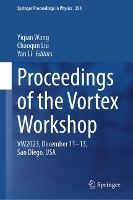


|
|
|
books
| book details |
Proceedings of the Vortex Workshop: VW2023, December 11-13, San Diego, USA
Edited by Yiqian Wang, Edited by Chaoqun Liu, Edited by Yan Li

|
This book is currently unavailable. Enquire to check if we can source a used copy
|
| book description |
Written by the leading experts in the field, this book results from Vortex Workshop 2023 which took place in San Diego, the USA, on December 11–13. Vortex is ubiquitous in the universe such as tornado, hurricane, airplane tip vortex, and even star vortex in Galaxy. Vortices are also building blocks, muscles, and sinews of turbulent flows. A vortex is intuitively recognized as a rotational/swirling motion of fluids but until recently had no rigidly mathematical definition. In 1858, Helmholtz first defined vortex as composed of so-called vortex filaments, which are infinitesimal vorticity tubes, which is called as the first generation of vortex definition and identification, or G1. Although G1 has been accepted by the fluid dynamics community and almost all textbooks for over a century, we can find many immediate counterexamples, for example, in the laminar boundary layer, where the vorticity (shear) is very large near the wall, but not rotation (no vortex) exists. To solve these contradictions, many vortex criteria methods have been developed during the past 4 decades. More popular methods are represented by the Q, ∆, criteria methods. These methods have achieved part of success in vortex identification, which are called the second generation of vortex identification or G2. However, G2 has several critical drawbacks. First, they are all scalars which have no rotation axis directions, but vortex is a vector. It is hard or impossible to use a scalar to represent a vector. Second, like vorticity, these criteria methods are all contaminated by shear in different degrees. Third, they are all very sensitive on threshold selections. The recently developed Liutex is called the third generation of vortex definition and identification, or G3, which is a uniquely defined vector.
| product details |
Normally shipped |
Publisher | Springer Verlag, Singapore
Published date | 16 Nov 2024
Language |
Format | Hardback
Pages | 246
Dimensions | 235 x 155 x 0mm (L x W x H)
Weight | 0g
ISBN | 978-9-8197-8607-7
Readership Age |
BISAC | science / mechanics / general
| other options |
|
|
|
To view the items in your trolley please sign in.
| sign in |
|
|
|
| specials |
|

|
Monde Ndandani
Paperback / softback
142 pages
was: R 220.95
now: R 198.95
|
|
|
Let's stare the future down and, instead of fearing AI, become solutionists.
|
|
|
|
|